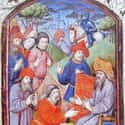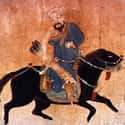-
(#11) Mongol Rule Pushed Ming China To Reject Outside Influences
When the Mongols conquered China, they established the Yuan Dynasty and pushed for harsh measures against the Chinese. Contrary to pre-Yuan rule, the Chinese were treated as second class citizens. Advisors were brought in from across the Mongolian Empire; no longer did the ethnic Chinese have control of their own country. Instead, foreigners made up the imperial court, held civil offices, and led troops. New laws were put in place to weaken Chinese unity and lessen the threat of rebellion. These included confiscating Chinese arms and imposing segregation between the Mongols and the Chinese.
In 1370, a long-brewing rebellion against the Yuan Dynasty established a new, Chinese dynasty: the Ming dynasty. The early Ming dynasty promoted strength and preparedness to prevent a Mongol reconquest. China also pushed traditional methods, cutting off much of the trade promoted by the Mongols and turning towards isolationism.
-
(#4) They Invaded The Islamic World When The Shah Massacred Mongol Diplomats
Genghis Khan might have stopped his conquest at the border of the Khwarezmid Empire in modern Northeastern Iran, but it was only due to a slight by the empire's ruler that Genghis Khan continued to expand his territory. He sent a diplomatic message to Shah Ala ad-Din Muhammad that read, "I am master of the lands of the rising sun, while you rule those of the setting sun. Let us conclude a treaty of friendship and peace."
After accepting the treaty, the Shah wiped out a Mongol trade caravan in 1219. The Mongol ruler sent diplomats demanding restitution, but the Shah ended them and sent their heads back to the Great Khan. The Mongols responded by marching into Persia, taking out Shah Muhammad and completely conquering the Khwarezmid Empire.
While the Mongols were remarkably flexible about adopting bureaucracies and religions from conquered regions, they placed a high value on trade and law - and when the Shah took the lives of traders and diplomats, he was faced with the Mongol wrath.
-
(#6) They Embraced Religious Diversity Within Their Empire
As ruler, Genghis Khan declared religious freedom in his empire. Genghis Khan ruled over a religiously diverse territory that included Buddhists, Christians, and Muslims. Suppressing these religions would have only antagonized the new Mongol subject, so Genghis Khan promoted an official policy of religious tolerance. Within the empire, religious leaders were exempt from taxation, and all subjects could practice any religion.
In governing his massive empire, Genghis Khan relied on advisors who practiced multiple faiths. The Mongol capital city of Karakorum contained churches, mosques, lamaseries, and temples to cater to the faiths of all subjects.
-
(#5) Many Enemies Fell For The Mongols' Feigned Flight Tactic
Mongol tactics completely wiped out their adversaries. They relied on their small, sturdy horses, light armor, and archery. More mobile than any other fighting force at the time, the cavalry could cover up to 100 miles in a single day.
During skirmishes, the Mongols tricked their enemies by using a feigned retreat tactic. A small force of riders would charge the enemy, then break and flee. As the enemy advanced, the feigned flight would lead them into an ambush. The technique helped the Mongols conquer the largest land empire the world had ever seen.
-
(#12) The Mongols Inspired European Explorers
During the Pax Mongolica, international trade flourished. For the first time, a single power governed the Silk Road, making it cheaper and less dangerous than ever before. For the first time, a large number of European merchants traveled the Silk Road.
One of them, Marco Polo, met Mongol ruler Khubilai Khan and reported back to Europe with tales of the riches of the East. Marco Polo's writings became so popular they inspired European explorers to find new routes to China once the collapse of the Mongol Empire made the Silk Road dangerous again. In fact, Christopher Columbus reportedly carried a copy of Marco Polo's Travels on his transatlantic voyage.
-
(#3) The Empire Helped Spread The Plague From Asia To Europe
The Plague originated in China when it was ruled by the Mongol Yuan Dynasty. Within three years of the disease's emergence, 90% of Hebei province's entire population had perished. Ironically, Mongol protection of Silk Road trade helped the disease spread.
The disease traveled with caravans to Middle Eastern trading centers, where Egyptian scholar Al-Mazriqi reported, "More than three hundred tribes all perished without apparent reason in their summer and winter encampments, in the course of pasturing their flocks and during their seasonal migration."
Along with the unintentional consequences of unfettered trade, the Mongols played an even more active role in spreading the disease. During a years-long siege of the Genoese-held city of Kaffa in 1347, the Mongol Golden Horde used germ warfare on the port city.
According to Italian lawyer Gabriele de Mussis, the Mongol leader "ordered corpses to be placed in catapults and lobbed into the city in hopes that the intolerable stench would [wipe out] everyone inside." The disease spread, and soon, "the [troops were] affected by a disease which overran the Tartars and [claimed] thousands upon thousands every day."
When the Genoese abandoned Kaffa to return to Italy, they carried the Plague with them.
New Random Displays Display All By Ranking
About This Tool
In the 13th century AD, Genghis Khan established a huge Mongolian Empire extending east to Northeast Asia, west to Central Asia and part of the Middle East, and south to the Indian Peninsula. In the historical narrative, the civilization where the Mongolian cavalry went was destroyed, and Mongolia was portrayed as a predatory and brutal conqueror in history. Many historians have been discussing whether the Mongolian Empire was the destroyer of civilization or the pioneer of globalization?
The Mongolian Empire expanded the territory crazily in a short period of time, Genghis Khan promoted Eurasian cultural exchanges, and the successive disintegration of Mongolian Khanates also prompted the emergence of a new Eurasian world. The random tool shares 12 things about how the Mongol Empire destroyed and improved the world.
Our data comes from Ranker, If you want to participate in the ranking of items displayed on this page, please click here.
















